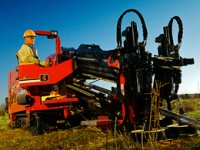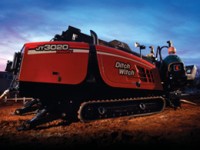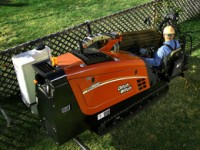Case Study 3 - Broomloan SPT
| Project Name | Broomloan/ Govan (Glasgow) Rail Depot (SPT), New Train wash Facility |
| Client | George Leslie |
| Requirements | Ducting for 66kV, 33kV, 11kV Electric Cables, Water Pipes and Data |
| Distance | Approximately 150 linear metres |
| Crossing | Multiple live rails and an active rail Subway System |
| Drilling Suggestion | 3 x 3 way 160mm o.d SDR 11 Ducts (9 x 160mm total) |
| Constraints | All rails to remain active at all times, all staff to be PTS trained |
| Ground Conditions | Clay/ Silt/ Sand |
| Installation time | 5 working days (7am - 6pm) |
Design
SW Directional Drilling were invited by George Leslie to design a Directional Drilling solution for a multi duct installation across multiple live rails and a subway system at Broomloan SPT (Govan, Glasgow). After enquiring about the utilities to be passed through the ducts, we decided that 160mm HDPE ducts would best suit the purpose needed by the client, which they agreed. After looking at the route via overhead and on site, it was decided that the drill should be on a continuous right hand curve to make best use of the available space for launch/ receive and pipe stringing. The overall distance estimated by the overhead was roughly 150 linear metres. For this task SW Directional Drilling decided that a DitchWitch 30/20 Mach 1 would suit the task nicely, given the fair to good ground conditions that were expected from the geotechnical investigation.
Below is a bore plan of the first drill, please click it to enlarge
Mobilisation and Commencement of Works
Once all method statements, risk assessments, bore plans and max settlement predictions were completed and passed by Network Rail, SW Directional Drilling were mobilised to site.
.jpg)
Day 1
After site inductions and excavations were carried out the Drilling Machine was unloaded. Once positioned at the launch pit the "incredabit" drill head was fitted with an internal transmitter (sonde) and calibrated to match the Sub-Site 750 Tracker locating system. With the area already previously scanned and marked for existing utilities, the drilling was ready to commence. The plan was to drill and install the first 3 way 160mm duct configuration centrally with the remaining two shots drilled with a shallow arc away and back in towards the centre pipelines to minimise the risk of crossover under the active subway.
With central markers set up between the surface rails, we drilled and checked the first 20 rods (60m) at 3m intervals and at 25% incline to give a depth of approximately 15m below rig level. This would enable us to be below the 7m level needed under the surface rails and to be at a depth of 11 meters before we approached the subway which was installed in a 4m deep cut out. As the subway was approaching the drill was steered up to 0% gradient over 4 rods (12m) and then checked for depth. The depth was indicated and calculated at around 16.5m. With the bore running exactly to plan the subway crossing was carried out over 3 rods (9m) with gradual incline steered up to 15% by the time the crossing was complete, giving us a head start towards meeting the receive pit. The drill was checked for depth post crossing and indicated at 15.8m, now it was time to get the drill out of the ground to meet the receive pit.
With the crossings complete the drill was then steered up and across at 2 O'clock to get a gradual bend and also increase incline upwards to meet the surface, a 25% incline up was calculated to be the optimum. Over the next 20 rods (60m) slight line adjustments were made to keep the first drill central with the required line and meet the centre of the receive pit, which it did at 1m, perfect!
Once the within the receive pit the drill was disconnected from the rods and fitted with a 300mm back reamer. The system was charged with water and one by one the rods were pulled back towards the drilling machine to expand the bore. Good ground conditions allowed the reaming to be carried out in an hour and once back at the drill rig, the reamer was sent back down the bore to the receive pit. The 300mm back reamer was then removed from the rods and then a 450mm reamer was fitted in it's place. The reaming process was then repeated, back to the rig, then back down the bore towards the receive area. This process is called "pre-reaming" and loosens up the bore whilst removing some of the unwanted cuttings to reduce pressures on the ground and drilling machine ready for pipe pullback.
Whilst the pilot drill and reaming operations were being carried out SW Directional Drilling's trained pipe fusing team were hard at work getting the pipes ready for pullback. Fusing 12m x 160mm sections of straight pipe together to make a 13 pipe 156m string (3 times for 3 way!).
By 3pm the pipe was ready for pullback and connected to the 450mm Back reamer via "mud tight" towing heads and chains. There were 3 hours still left in the working day so it was decided to pull the pipe in to hit a good milestone for the working week. 1 hour later the first 3 way 160mm Duct installation was complete, much to the amazement of allot of the site staff and a very pleased client. The equipment was then cleaned down, packed up and put to bed for the night ready for the next days operations, with a 3 way 160mm x 150m crossing of subway and 4 live rails carried out within 9 hours!
Day 2
Pilot drilled the left hand bore from the same launch pit with minimum 3m separation beneath the subway, slightly harder ground for this drill and a little more complex steering required. Once the depth was reduced to around 6m after crossing the subway the drill was steered back in right to meet the receive pit at 1m separation from the first set of installed ducts. Drill was then removed and pre-reamed with 300mm then 450mm. The 3 x 160mm x 156m pipe string was being welded whilst drilling operations were being carried out.
Day 3
As the bore was left overnight and ground conditions a little tougher, it was decided to pre-ream the bore again with the 450mm to ensure good fluid transmission within the bore. The pipes were then connected and pulled in with no problems and the equipment cleaned off. Heavy rain hit in the afternoon and caused problems for the excavators and other things happening on site, so for safety reasons it was agreed by all that operations should cease around the live tracks.
Day 4
With the launch area back to normal and slightly less wet, drilling operations re-commenced and the 3rd pilot bore was installed before lunch. This was angled right, away from the first bore and was then like the second one, steered back in to meet the reception pit at 1.1m, with 1m separation from the first drill. Whilst this was being carried out SW Directional Drilling's pipe welders were hard at work fusing the remaining pipes in some tough, and now extremely muddy conditions, apparently this was the norm for Scotland the site lads kept saying! Once at the reception pit the drill was again removed and replaced with a 300mm reamer. The bore was then pre-reamed with the 300mm and then again with the 450mm. It was decided that with only 1 hour left in the working day it was probably unwise to commence pipe pullback so the equipment was packed up and everyone headed back to the hotel.
Day 5
Yet again, as with the previous installation it was felt unwise to go straight into pullback after leaving the bore overnight so the bore was pre reamed to 450mm again. Once complete the pipes were then connected and pullback was complete within the hour. All the machinery, equipment and tooling were then cleaned and packed up ready for de-mobilisation. A quick de-brief from the ecstatic client and it was time to get back on the road after another highly successful project.
Case Study by Chris Weatherall of SW Directional Drilling






























.jpg)












